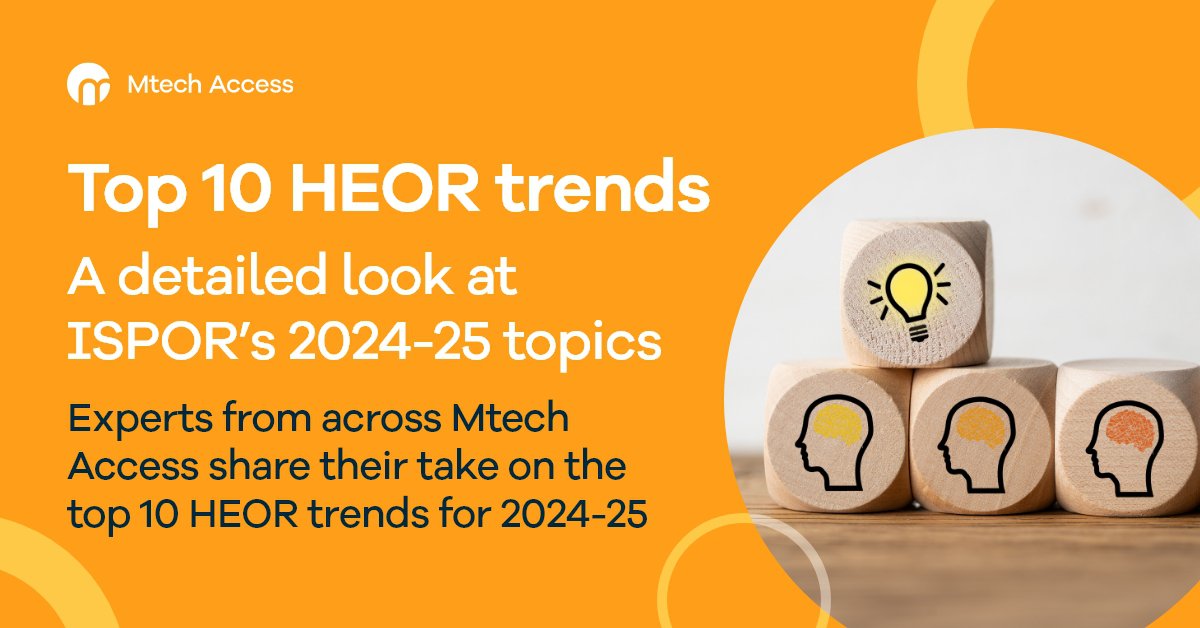
We bring specialists together from across Mtech Access to look at each of ISPOR’s top 10 HEOR trends for 2024–2025. Jump in as our experts give their hot take on each trend, sharing their perspectives on the topics in these areas (get ready – it’s a jam-packed read!).
Sections
- Real-World Evidence by Clare Foy (Director – Global Market Access)
- Drug Pricing by Louise Maddison (Senior Consultant – Global Market Access)
- Artificial Intelligence by Richard Johnson (Senior Management Consultant – Innovation), Louise Maddison (Senior Consultant – Global Market Access), and Emily Hardy (Associate Consultant – Systematic Review)
- Fostering Innovation by Phil Richardson (Chair & Chief Innovation Officer)
- Health Equity by Chloe Morris (Associate Management Consultant – Innovation)
- Accelerating Drug Approvals by Samantha Gillard (Director – HTA)
- Value Measurement by Kaylie Metcalfe (Consultant – Health Economics)
- Patient Centricity by Louise Maddison (Senior Consultant – Global Market Access)
- Precision Medicine by Stephanie Swift (Senior Consultant – Systematic Review)
- Public Health Policy by Robert Hull (Senior Consultant – NHS Insight & Interaction)
Executive Summary
Hayley Shoel and Abigail Beveridge, from our Medical Writing Team, outline what to expect from this paper in the below Executive Summary.
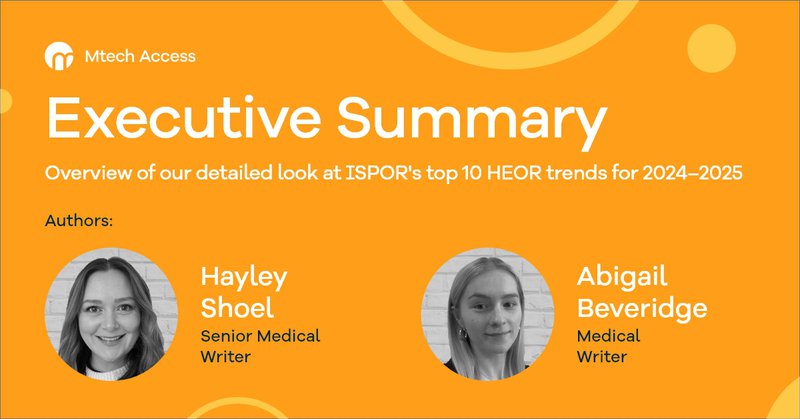
In January 2024, ISPOR published their ‘2024–2025 Top HEOR Trends’ report, a horizon scanning publication that highlighted key trends affecting healthcare decision-making around the world.
Since these trends resonate with our own research and activities here at Mtech Access, experts within our team have come together to share their perspectives on each of the trends. In this article, we highlight considerations for Pharma and Medtech companies looking to optimise success in market access.
We begin with a look at how Real-World Evidence (RWE) is increasingly used for regulatory and reimbursement decision-making. The authors explain how data can be collected, and spotlight the frameworks available for guidance on optimising the use of RWE.
We particularly recommend the section on Artificial Intelligence (AI), a hot topic across all sectors. Likewise, don’t miss the Fostering Innovation section, where Phil Richardson (Chair & Chief Innovation Officer) shares his insights into the importance of innovation in healthcare. He highlights Mtech Access’ initiative, the ‘Above Brand Academy’, which aims to foster collaboration between the NHS, Pharma, Medtech, and market access, to identify innovative solutions to system-, therapy area-, and disease-level problems.
Samantha Gillard (Director – HTA) explores Accelerated Drug Approval Pathways and their associated challenges. She discusses how HEOR can aid with filling data gaps and the importance of considering the ‘fourth hurdle’ of recommendation for reimbursement.
Plus much more – keep scrolling to dive in!
Real-World Evidence
Authors: Clare Foy (Director – Global Market Access)
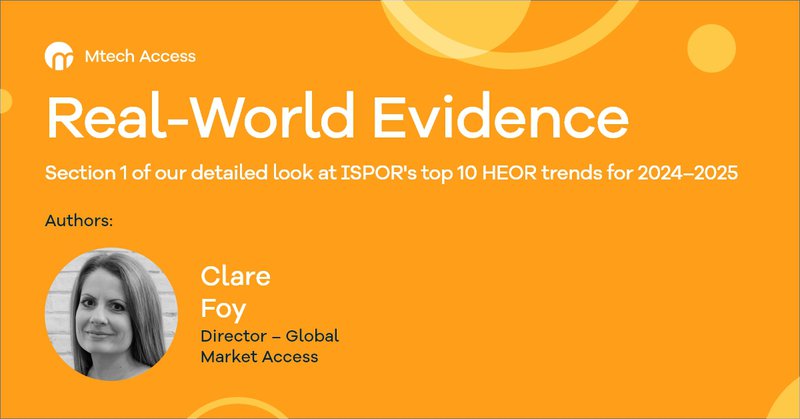
What is real-world evidence?
Real-world evidence (RWE) is fast becoming an innovative way to expand how we assess the value of healthcare interventions. Defined by NICE as “evidence generated from the analysis of real-world data”, RWE encompasses evidence generated from real patients using a range of study designs and analytical methods, depending on the research question (1).
RWE studies leverage real-world data (RWD), which relate to patient health status and/or the delivery of healthcare routinely collected from a variety of sources (2–4, 9). RWD helps us to understand how interventions are used in real patients, and the potential benefits and/or risks associated with their use (2–4, 9).
RWD includes electronic patient records, administrative data, claims data, registry data, patient-generated health data, and data from chart reviews and audit and service evaluations. Other examples include primary data from observational cohorts, health surveys, interviews, focus groups, social media, and patient advocacy groups (1–4).
Data can be qualitative or quantitative, and can be collected in a structured, semi-structured, or unstructured format, prospectively or retrospectively (1, 3, 11). RWE analytics can be used to extract deeper insights from rich data sets (6, 9). Artificial intelligence can also be used to analyse unstructured data and speed up the analysis process (9, 11).
Why is it important to consider RWE in decision-making?
Regulatory and reimbursement decision-making is largely informed by evidence generated in a randomised controlled trial (RCT) setting (5). RWE serves to complement this evidence base, as it enables decision makers to understand the safety and effectiveness of interventions outside of a controlled environment (3, 5, 8, 9). It also helps to provide therapeutic context for decision-making, for example, regarding the expansion of label indications (9, 10).
RWE generates real-world insight into how interventions impact real patient outcomes and experiences, and service delivery by healthcare systems (3, 6). Consideration of RWE in decision-making therefore drives timely access to innovative therapies that meet the needs of real-world patients, which may not be wholly reflected in RCT settings (4, 8, 10).
How else can we use RWE?
RWE can be used to create guidelines for clinical and social care, and public health issues by characterising health conditions, interventions, care pathways, and patient experiences (1).
RWE also informs our understanding of the economic burden of disease and how economic models are designed, populated, and validated (1). More importantly, the analysis of RWE can support with identifying and addressing health inequalities, ensuring equity of access to healthcare services for vulnerable groups in society (1).
Helpful resources
There are several RWE frameworks available that provide guidance on the use of RWE, including assessing the quality of data sources, and how RWE can be utilised for regulatory and market access purposes.
These are available from the following organisations (this list is not exhaustive):
References
- NICE. Real-world evidence framework (ECD9). 2024. Available from: https://www.nice.org.uk/corporate/ecd9/resources/nice-realworld-evidence-framework-pdf-1124020816837. Accessed February 2024.
- U.S. FDA. Real-World Evidence. 2023. Available from: https://www.fda.gov/science-research/science-and-research-special-topics/real-world-evidence. Accessed February 2024.
- U.S. FDA. Framework For FDA’s Real-World Evidence Program. 2018. Available from: https://www.fda.gov/media/120060/download?attachment. Accessed February 2024.
- Chodankar D. Introduction to real-world evidence studies. Perspectives in clinical research. 2021;12(3):171.
- EMA. Real-world evidence framework to support EU regulatory decision-making: Report on the experience gained with regulator-led studies from September 2021 to February 2023. 2023. Available from: https://www.ema.europa.eu/en/documents/report/real-world-evidence-framework-support-eu-regulatory-decision-making-report-experience-gained-regulator-led-studies-september-2021-february-2023_en.pdf. Accessed February 2024.
- Champagne D, Deverson A, Pérez L, Saunders D. Creating value from next-generation real-world evidence. 2020. Available from: https://www.mckinsey.com/industries/life-sciences/our-insights/creating-value-from-next-generation-real-world-evidence#/. Accessed February 2024.
- ISPOR. ISPOR 2024–2025 Top 10 HEOR Trends. 2024. Available from: https://www.ispor.org/heor-resources/about-heor/top-10-heor-trends. Accessed February 2024.
- ISPOR. Unlocking The Promise of Real-World Evidence. Value & Outcomes Spotlight. 2020;6(5):26-8.
- Deloitte Insights. Real-world evidence’s evolution into a true end-to-end capability. 2022. Available from: https://www2.deloitte.com/us/en/insights/industry/health-care/real-world-evidence-study.html. Accessed February 2024.
- Cronenwett J. How Real-World Evidence Helps Medical Device Manufacturers Drive Value. 2023. Available from: https://medtechintelligence.com/column/how-real-world-evidence-helps-medical-device-manufacturers-drive-value/. Accessed February 2024.
- Jayne J. Realising the Promise of Real-World Evidence in MedTech. 2022. Available from: https://medtechintelligence.com/feature_article/realizing-the-promise-of-real-world-evidence-in-medtech/. Accessed February 2024.
Drug Pricing
Author: Louise Maddison (Senior Consultant – Global Market Access).
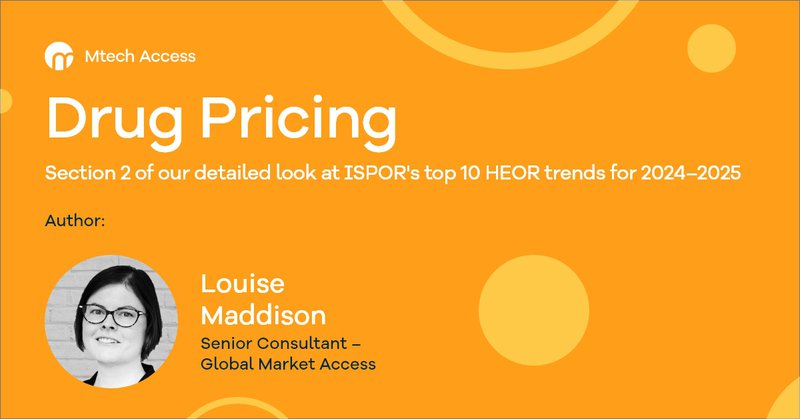
The drug pricing landscape in the United States
The Inflation Reduction Act (IRA) was introduced in 2022 to address drug pricing and Medicare expenditure in the US. The IRA outlined several reforms relating to direct negotiation, the Part D redesign, and the inflation price cap (1).
Importantly, the IRA has empowered the Centers for Medicare & Medicaid Services to negotiate prices on behalf of Medicare for the first time (1, 2). Price negotiations for 10 drugs started in 2023, with price changes taking effect in 2026 (1, 2). The IRA drug pricing provisions are estimated to reduce the federal deficit by an estimated US$237 billion by 2031 (3).
The initial 10 drugs include medications for the treatment of blood clots, diabetes, and autoimmune diseases (1, 2). They were chosen primarily due to their high-expenditure status, although generic availability and time on the market were also considered (1, 2). By 2029, a cumulative total of 60 drugs will have been selected for negotiation (4).
At first glance, these reforms only affect a few brands in the short term; however, there will be a ripple effect both for within-class competitors and beyond the Medicare population. Prices for competitors within each class are likely to be affected, and potentially extend to other populations, as commercial payers may push for lower prices and want the same price offered to Medicare.
The inflation price cap will mean that manufacturers will be required to pay a rebate if the increase in drug prices exceeds the rate of inflation. Additionally, as part of the Part D redesign plans, manufacturers will also be required to increase their share of the costs that surpass the out-of-pocket spending cap. The Part D changes will also limit beneficiary premium increases to 6% annually; therefore, payers will look to mitigate their own increased liability by actively managing drug costs and there may be a shift towards value-based pricing in the US.
The changing landscape for drug pricing in Europe
The European Commission is proposing the largest reform in over 20 years to the European Union’s Pharmaceutical legislation. Through a patient-centred approach, the reforms will mean that patients across the European Union will have timely and equitable access to safe, effective, and affordable medicines (5).
Access to new treatments across the 27 member states of the European Union varies broadly. In 2023, patients in Germany could access 88% of medicines approved by the EMA between 2018 and 2021. Comparatively, patients in Turkey could access only 6% (6). A single market for medicines is needed to reduce these disparities.
Although pricing and reimbursement decision-making will remain with member states, the European Commission will foster transparency of price information and launch a group to steer cooperation between national pricing and reimbursement (7).
Payers are now working more closely together through the group of National Competent Authorities on Pricing and Reimbursement and Public Healthcare Payers (NCAPR), which was an ad hoc forum, but now promotes continuous voluntary cooperation (7, 8).
The European Commission further supports increased cooperation to improve affordability through joint procurement process, such as the BeNeLuxA initiative between Belgium, the Netherlands, Luxembourg, Austria, and Ireland (9), as well as the Nordic Pharmaceutical Forum (10).
As such, we may see more instances of member states banding together to increase their bargaining power through joint negotiations, and before legislation is adopted, especially with current financial pressures across healthcare systems.
The reforms also propose 2 years of data protection conditional on launch of a new medicine across all member states (7), as well as measures to encourage early market access of generic and biosimilar medicines. However, opinions are still divided on the proposed changes to the European Commission’s draft, despite time ticking down on the current parliamentary term before proceedings are suspended for the 2024 European Parliament elections (11).
European Union Joint Clinical Assessment
In other news, the European Union Joint Clinical Assessment (EU JCA) will kick off in 2025 (to read more about EU JCA, see our recent article). As EU JCA reports are non-binding, it remains unclear as to what extent individual member states will use the information, and the impact that it will have on pricing and reimbursement decision-making.
In preparation for these reforms to the landscape both in the US and Europe, manufacturers need to be alert to ongoing changes and to be agile in their pricing strategy at launch, as well as ongoing life cycle management of medicines already on the market.
References
- U.S. Centers for Medicare & Medicaid Services. Medicare Drug Price Negotiation Program: Selected Drugs for Initial Price Applicability Year 2026. 2023. Available from: https://www.cms.gov/files/document/fact-sheet-medicare-selected-drug-negotiation-list-ipay-2026.pdf. Accessed February 2024.
- U.S. Department of Health and Human Services. HHS Selects the First Drugs for Medicare Drug Price Negotiation. 2023. Available from: https://www.hhs.gov/about/news/2023/08/29/hhs-selects-the-first-drugs-for-medicare-drug-price-negotiation.html. Accessed February 2024.
- Congressional Budget Office: Nonpartisan Analysis for the U.S. Congress. How CBO Estimated the Budgetary Impact of Key Prescription Drug Provisions in the 2022 Reconciliation Act. 2023. Available from: www.cbo.gov/system/files/2023-02/58850-IRA-Drug-Provs.pdf. Accessed February 2024.
- The White House: Statements And Releases. FACT SHEET: Biden-Harris Administration Announces First Ten Drugs Selected for Medicare Price Negotiation. 2023. Available from: https://www.whitehouse.gov/briefing-room/statements-releases/2023/08/29/fact-sheet-biden-harris-administration-announces-first-ten-drugs-selected-for-medicare-price-negotiation/. Accessed February 2024.
- European Commission. Reform of the EU Pharmaceutical legislation: Affordable, accessible, and innovative medicines. 2023. Available from: https://commission.europa.eu/strategy-and-policy/priorities-2019-2024/promoting-our-european-way-life/european-health-union/reform-eu-pharmaceutical-legislation_en. Accessed February 2024.
- Statista. Share of medicines approved by the EMA available to patients in Europe as of 2023, by country. 2023. Available from: https://www.statista.com/statistics/1011186/rate-of-medicine-availability-europe-by-country/. Accessed February 2024.
- European Commission. Communication From The Commission To The European Parliament, The Council, The European Economic And Social Committee And The Committee Of The Regions: Reform of the pharmaceutical legislation and measures addressing antimicrobial resistance. 2023. Available from: https://eur-lex.europa.eu/legal-content/EN/TXT/PDF/?uri=CELEX:52023DC0190. Accessed February 2024.
- Meeting of the National Competent Authorities on Pricing and Reimbursement and Public Healthcare Payers (NCAPR). Conference Proceedings. 2023. Conference date: 30thMarch 2023. Conference location:Stockholm/Webex. Available from: https://health.ec.europa.eu/document/download/3f428d22-966e-447b-909c-63a2f3d64301_en?filename=mp_20230330_mi_en_.pdf. Accessed February 2024.
- Beneluxa Initiative on Pharmaceutical Policy. Beneluxa Initiative. 2024. Available from: https://beneluxa.org/collaboration. Accessed February 2024.
- Sonne F, Juhl TN, Andreassen E, Aufrecht-Gustafsson M, Svensson M, Þórhallsdóttir Ó, et al. Nordic Pharmaceutical Forum: Strategy for 2023–2025. Available from: https://amgros.dk/media/3790/nlf-strategy-final.pdf. Accessed February 2024.
- Science Business Publishing. As time runs out, the European Parliament remains divided over pharma reform. 2023. Available from: https://sciencebusiness.net/news/drug-development/time-runs-out-european-parliament-remains-divided-over-pharma-reform. Accessed February 2024.
Artificial Intelligence
Authors: Richard Johnson (Senior Management Consultant – Innovation), Louise Maddison (Senior Consultant – Global Market Access), and Emily Hardy (Associate Consultant – Systematic Review).
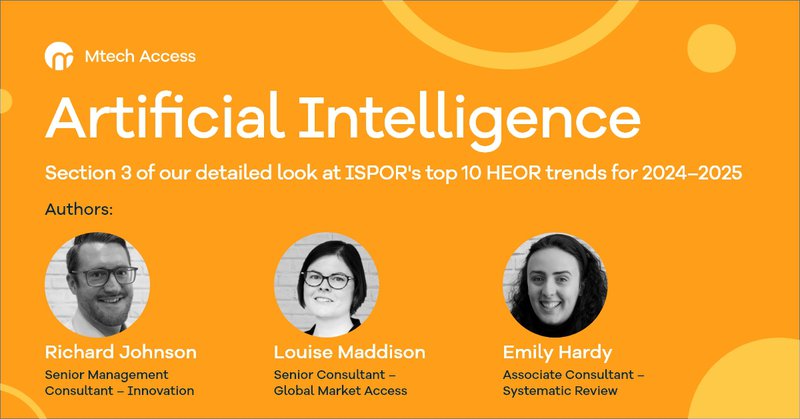
AI in HEOR – The current landscape
Artificial intelligence (AI) permeates everyday life, through technologies such as GPS navigation, digital assistants, and eCommerce. Nonetheless, the launch of ChatGPT by OpenAI in November 2022 revolutionised the world’s understanding of generative AI and the broader applications of technology automation.
Large language models (LLMs) packaged into a chatbot interface, like ChatGPT, have since been launched by organisations such as Microsoft and Google, indicating the extent of AI’s impact. To ensure that our team at Mtech Access and our clients remain ahead of the curve, we take a keen interest in advances of AI in healthcare, particularly their potential applications in HEOR and market access strategy.
AI use in the healthcare industry has accelerated globally in recent years. We have seen regulatory submissions of AI enabled devices (e.g. in radiology), plus the use of AI to support healthcare service redesign. AI has also been used to transform drug development, clinical operations, and regulatory processes (1–4).
The future of AI in healthcare
AI is likely to have a more powerful impact across the entire healthcare value chain than any other previous technology. This is because AI serves to improve healthcare outcomes (e.g. predicting disease risk, personalised treatments), whilst also introducing efficiencies for societies burdened by increasing healthcare costs (5).
Significant initiatives and investments are enabling the implementation of AI in healthcare. The World Health Organization has set up a Global Initiative on AI for Health (6), whilst the European Union has committed €50 million to funding world-class testing and experimentation facilities in healthcare (known as TEF-health) (7). The Bill and Melinda Gates Foundation has also committed US$5 million to equitable access to AI in healthcare (8).
In October 2023, the UK government committed £100 million to AI medical advancement research through the AI life sciences accelerator mission (9). Through a collaborative effort with government, industry, the NHS, and academia, the accelerator aims to drive breakthrough interventions for previously incurable diseases and conditions with high mortality and morbidity.
This effort has seven key aims:
- Accelerating the pace of studies into novel dementia treatment
- Increasing the understanding of mental health conditions, including redefining diseases and developing tools to address them
- Reducing mortality and morbidity from respiratory disease in the UK and globally
- Treatment and prevention of cardiovascular disease and its major risk factors, including obesity
- Enabling early diagnosis and treatments, including immune therapies (such as cancer vaccines)
- Sustaining the UK’s position in vaccine discovery, development, and manufacturing
- Addressing the underlying biology of ageing
These commitments will provide Pharmaceutical and Medtech companies with opportunities to overcome the key challenges in AI adoption, such as investment in data analytics, systems, process, and training (business change and transformation) (10).
Our insights on AI
Calum Jones recently spoke with Dr George Magrath (CEO, Lexitas) about the use of AI in clinical trials (11).
They discussed how AI technologies can help to understand how patients are likely to respond to an intervention, which can help refine clinical trial endpoints. This means that clinical trials can be kept to a minimum required size, whilst retaining sufficient statistical power to demonstrate intervention safety and efficacy (11).
They also discussed how AI can be used to identify the most appropriate patients for enrolment, which increases the speed to clinical trial. This AI-enabled approach is particularly suitable for rare diseases, but can help patients gain faster access to medications regardless of indication (11).
Considerations for the use of AI in healthcare
Amongst the excitement, the use of AI raises concerns around data protection, data quality, and ethics. As technology advances, the latest guidance, frameworks, and evidence requirements should remain at the forefront of discussions related to AI solutions.
No industry-wide framework has been adopted yet, but several resources are available (12–18). In addition, NICE has developed the evidence standards framework for digital health technologies to support digital health market access in England (17). The framework outlines how new digital health technologies should be assessed, to ensure that they are clinically effective and offer value to health care systems (19).
The NICE META tool can be used to assess digital technologies like AI. The tool serves to address gaps in evidence and development plans, to understand how AI technologies can be brought to market. Samantha Gillard, along with colleagues Calum Jones and Hannah Palin recently discussed the role of the NICE META tool in evidence strategy (20).
The use of AI automation in HEOR and market access strategy
Moving from clinical development onto HEOR and market access strategy, AI automation can be applied at various stages. It can be used to support predictive analytics for drug pricing, improving efficiencies in systematic literature reviews (SLRs) and regulatory submissions, and to pre-empt the outcome of HTA agency negotiations.
AI automation tools optimise time and provide budget savings, which can help a business stay competitive in an evolving market. That said, the decision to use AI automation tools should not be taken lightly. Considerations regarding output quality, methodological transparency, data security, and ethical responsibility are vital before selecting a tool in this increasingly saturated field.
Relevant published guidance on the use of automated tools to support HEOR should also be considered. For example, the use of AI automated tools for conducting SLRs is not currently part of guidance issued by Preferred Reporting Items for Systematic Reviews and Meta-Analyses (PRISMA) (18) or NICE for health technology assessment submissions (21), but is highlighted in the Cochrane Handbook (19). As a result, there remains ambiguity in the HEOR community about the acceptance of using AI automation tools to support SLR methodology.
The future of AI in market access
It is important to work with agencies who have a strong technical understanding of the market access landscape and the capabilities needed to develop and deliver market access strategies in key global markets.
As AI continues to permeate the healthcare industry, we must keep up with the changing landscape of reimbursement pathways and evidence requirements. Only then can Pharmaceutical and Medtech companies stay ahead of the AI adoption curve and reap the benefits that this technology can bring.
References
- U.S. FDA. Artificial Intelligence and Machine Learning (AI/ML) – Enabled Medical Devices. 2023. Available from: https://www.fda.gov/medical-devices/software-medical-device-samd/artificial-intelligence-and-machine-learning-aiml-enabled-medical-devices. Accessed February 2024.
- NHS England. The NHS AI Lab: Accelerating the safe adoption of artificial intelligence in health and care. Available from: https://transform.england.nhs.uk/ai-lab/. Accessed February 2024.
- U.S. FDA. Using Artificial Intelligence & Machine Learning in the Development of Drug & Biological Products. 2023. Available from: www.fda.gov/media/167973/download. Accessed February 2024.
- U.S. Department of Health and Human Services. Department of Health and Human Services: Artificial Intelligence Use Cases Inventory. 2024. Available from: https://www.hhs.gov/about/agencies/asa/ocio/ai/use-cases/index.html. Accessed February 2024.
- World Economic Forum: Health and Healthcare. 5 steps to put healthcare on the AI fast-track. 2024. Available from: https://www.weforum.org/agenda/2024/01/healthcare-ai/. Accessed February 2024.
- World Health Organization. Global Initiative on AI for Health. 2024. Available from: https://www.who.int/initiatives/global-initiative-on-ai-for-health. Accessed February 2024.
- European Commission. Shaping Europe’s digital future: Sectorial AI Testing and Experimentation Facilities under the Digital Europe Programme. 2024. Available from: https://digital-strategy.ec.europa.eu/en/activities/testing-and-experimentation-facilities. Accessed February 2024.
- Bill & Melinda Gates Foundation. Gates Foundation Selects Nearly 50 Global Health and Development Projects That Will Contribute to Shaping Equitable Access to AI. 2023. Available from: https://www.gatesfoundation.org/ideas/media-center/press-releases/2023/08/grand-challenges-rfp-recipients-ai-large-language-models. Accessed February 2024.
- GOV.UK. Technology in health and social care. Press release: New £100 million fund to capitalise on AI’s game-changing potential in life sciences and healthcare. 2023. Available from: https://www.gov.uk/government/news/new-100-million-fund-to-capitalise-on-ais-game-changing-potential-in-life-sciences-and-healthcare. Accessed February 2024.
- GOV.UK. Research and innovation in health and social care. News story: UK life sciences vision set to deliver life-changing innovations. 2021. Available from: https://www.gov.uk/government/news/uk-life-sciences-vision-set-to-deliver-life-changing-innovations. Accessed February 2024.
- Mtech Access. Artificial intelligence (AI) in clinical trials: implications for evidence synthesis and market access. 2023. Available from: https://mtechaccess.co.uk/ai-clinical-trials-evidence/. Accessed February 2024.
- U.S. FDA. Marketing Submission Recommendations for a Predetermined Change Control Plan for Artificial Intelligence/Machine Learning (AI/ML)-Enabled Device Software Functions: Draft Guidance for Industry and Food and Drug Administration Staff. 2023. Available from: https://www.fda.gov/regulatory-information/search-fda-guidance-documents/marketing-submission-recommendations-predetermined-change-control-plan-artificial. Accessed February 2024.
- GOV.UK. Guidance: Software and Artificial Intelligence (AI) as a Medical Device. 2023. Available from: https://www.gov.uk/government/publications/software-and-artificial-intelligence-ai-as-a-medical-device/software-and-artificial-intelligence-ai-as-a-medical-device. Accessed February 2024.
- WHO. Regulatory considerations on artificial intelligence for health. 2023. Available from: https://www.who.int/publications/i/item/9789240078871. Accessed February 2024.
- WHO. Ethics and governance of artificial intelligence for health: Guidance on large multi-modal models. 2024. Available from: https://www.who.int/publications/i/item/9789240084759. Accessed February 2024.
- National Academy of Medicine. Health Care Artificial Intelligence Code of Conduct. 2024. Available from: https://nam.edu/programs/value-science-driven-health-care/health-care-artificial-intelligence-code-of-conduct/. Accessed February 2024.
- NICE. Evidence standards framework for digital health technologies (ECD7). 2022. Available from: https://www.nice.org.uk/corporate/ecd7. Accessed February 2024.
- Page MJ, Moher D, Bossuyt PM, Boutron I, Hoffmann TC, Mulrow CD, et al. PRISMA 2020 explanation and elaboration: updated guidance and exemplars for reporting systematic reviews. British Medical Journal. 2021;372.
- Cochrane Training. Cochrane Handbook for Systematic Reviews of Interventions: Version 6.4. 2023. Available from: https://training.cochrane.org/handbook/current. Accessed February 2024.
- Mtech Access. Evidence strategy for Medical Technologies and Diagnostics. 2023. Available from: https://mtechaccess.co.uk/evidence-strategy-for-medical-technologies-and-diagnostics/. Accessed February 2024.
- NICE. Single technology appraisal (STA): Specification for manufacturer/sponsor submission of evidence. 2012. Available from: https://www.nice.org.uk/media/default/about/what-we-do/nice-guidance/nice-technology-appraisals/specification-for-manufacturer-sponsor-submission-of-evidence-june-2012.doc. Accessed February 2024.
Fostering Innovation
Author: Phil Richardson (Chair & Chief Innovation Officer).
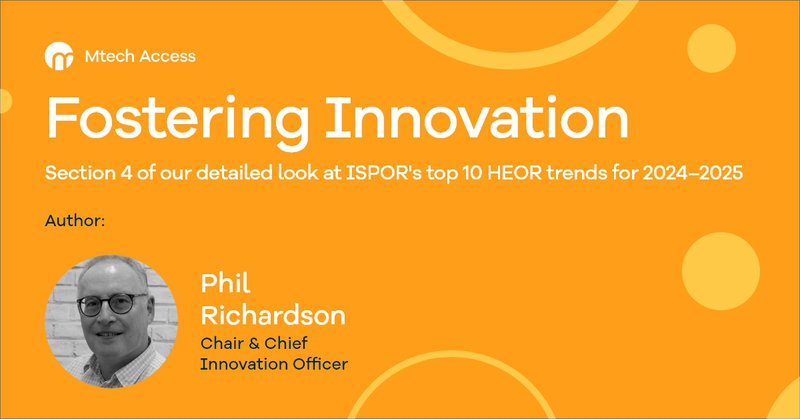
Looking beyond product
In the commercialisation of Pharmaceutical and medical technology interventions, innovation spans the whole value chain, from drug discovery to patient use, and remains the biggest source of sustainable competitive advantage. However, it will struggle to deliver meaningful changes in healthcare if the focus remains on just developing products.
Innovation includes case finding, which can seem counterintuitive, particularly for organisations that market products and services for the end of complex disease pathways. There is a tension between some traditional approaches of pharmaceutical treatment and the drive by healthcare systems to identify cases earlier.
Patients who are pre-diabetic or pre-cancer, where there may not be an obvious marker, need innovative thinking and brave decisions about resource allocation. Identifying disease early in patients, as a mantra, could change paradigms for research and development priorities, as well as the go-to-market strategies for traditional products.
Being the first organisation to bring a product to market does not translate to being the most successful; focus on business models, culture, service delivery, and patient quality of care and safety may be more valuable (1).
The holistic view of a product indeed includes the product itself, but also its delivery and impact on the patient experience. This is known as product surround. In other industries, the innovation of product surround versus the product alone is advocated for (1), yet pharmaceutical innovations mostly focus on the product alone.
More investment is needed to innovate how healthcare service and delivery, and the products themselves, interact with one another. Focusing too heavily on the product alone means that the transformative opportunities and synergies that exist could be overlooked. Patient centricity is at the core of innovative solutions.
The transformative power of innovation in healthcare
NHS England acknowledge that innovation “not only transforms patients’ lives, but also brings significant benefits to the UK economy and society” (2). The NHS Accelerated Access Collaborative has outlined the ingredients for innovative success (2). These include a focus on defined stages for innovation, how clinical skills and leadership can be best utilised, redesign of the treatment pathway to foster innovation, and the need to focus on local versus national scale implementation (2).
Innovation comes from diversity of thinking, experience, motivation, empowerment, engagement, co-design, co-production and, observation. Data collected ethnographically through active observation is more insightful than analysis of historical data. It is critical that we sense-and-respond to the current landscape, rather than catalogue historical transactions based on traditional understanding.
Funding innovation in healthcare
Funding and incentives are also critical for fostering innovation (2). Limited funding for future therapies stifles what is possible. Equally, healthcare systems with budget and resource constraints are unable to innovate beyond symptom-led problem solving. Game-changing approaches, which seem obvious with hindsight, are needed.
One example of this is our plan for an Above Brand Academy, which is an Mtech Access initiative focused on establishing partnerships between the NHS, Pharma, Medtech, and market access. It will create a collaborative space for organisations to work above-brand and above-symptom to innovate aetiology-based solutions.
By fostering innovation and pushing the boundaries for industry, the Above Brand Academy will offer opportunities to work alongside the health service to develop sustainable changes using a combination of applied resources. It is an opportunity for global strategists and in-market expertise to connect with healthcare professionals, payers, policy makers, and operational leads.
The approach is theme based, with a recent focus on cancer and early identification generating meaningful follow-up conversations. Over time the intent is to bring in a strong patient voice that is representative of the theme being examined.
More help is at hand. In the UK, the refocusing of Academic Health Science Networks into Health Innovation Networks signals the ambition to drive innovation adoption at scale. The NHS Clinical Entrepreneur Programme brings clinical entrepreneurs right into the heart of the NHS (3). The NHS Digital Academy has also been set up to drive excellent digital leaders in NHS England (4).
Get a jump start by talking to the Innovation Team at Mtech Access.
References
- Forbes. Leadership: Don’t Waste Innovation on Products. 2013. Available from: https://www.forbes.com/sites/christinecrandell/2013/02/03/best-innovation-doesnt-come-in-products/. Accessed February 2024.
- NHS England. Blog: The ingredients for success: how to bake innovation into the NHS. 2023. Available from: https://www.england.nhs.uk/aac/2023/12/11/blog-the-ingredients-for-success-how-to-bake-innovation-into-the-nhs/. Accessed February 2024.
- NHS Clinical Entrepreneur Programme. Supporting innovation in the NHS. 2022 [AB4] . Available from: https://nhscep.com/. Accessed February 2024.
- NHS England. NHS Digital Academy. 2024[AB5] . Available from: https://www.england.nhs.uk/digitaltechnology/nhs-digital-academy/. Accessed February 2024.
Health Equity
Author: Chloe Morris (Associate Management Consultant – Innovation).
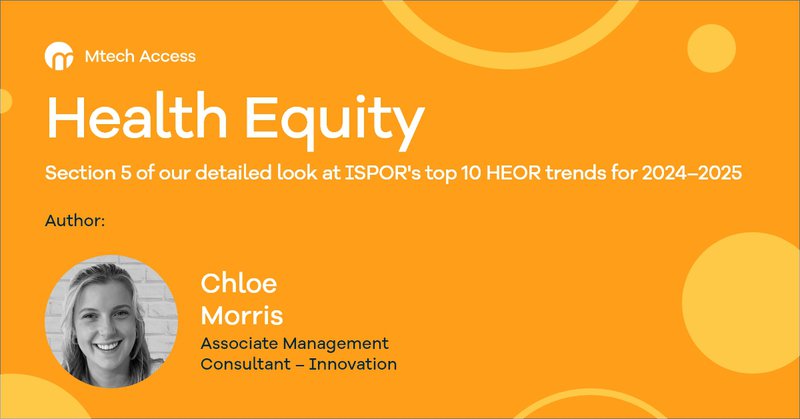
Health equity is a fundamental human right that ensures every individual has access to the highest attainable standard of health without discrimination or bias. It also aims to achieve the highest level of health for all people (1).
Health equity versus health equality
Health equity and health equality are two distinct concepts. They refer to differences in health outcomes between distinct groups of people.
Health equity aims to achieve fairness in health outcomes by addressing systemic barriers and providing resources based on individual needs. It recognises that different populations have varying health needs and aims to eliminate unjust differences (1).
On the other hand, health equality provides the same level of care to everyone, regardless of their specific needs. It assumes that equal treatment will lead to equal outcomes, but this approach may not account for existing disparities (2).
It is important to focus on these differences to be able to address health disparities and promote health equity for all individuals and communities. The goal to achieve health equity is shared by various organisations and initiatives, including the All Our Health initiative(3), Department of Health and Human Services (HHS), and the World Health Organisation (4). Health equity has re-emerged as a prominent trend for 2024/2025 in the realm of HEOR, having previously featured in the 2022/2023 HEOR report (5).
The relationship between funding and health equity is complex. In the UK, the NHS has been criticised for differential quality and funding in health equity. A national survey found that equity is not addressed systematically below strategic levels, and equity does not shape funding decisions, programme development, implementation, and monitoring.
However, there are several initiatives that address social determinants of health, such as the Thrive LDN Partnership (6), the NHS Health check programme (7), and the Healthy Start programme (8), which involve identifying and preventing cardiovascular disease, and improving access to healthy food for families on low incomes.
Addressing health equity
Addressing health equity and inequality requires a focus on neighbourhoods, communities, and populations, and putting the person at the centre of decision-making. Agencies cannot do this on their own; they need to be intricately connected to health systems, primary care, and secure health data environments.
At Mtech Access, we understand the importance of health equity, and are on focusing initiatives such as population health management. This is a data-driven, proactive care approach to reduce inequalities and optimise health outcomes across different populations, sub-populations, and individuals. As we carve out a path towards a future that is healthier and equitable, it is crucial that we position individuals at the heart of decision-making.
References
- WHO. Health Equity. Available from: https://www.who.int/health-topics/health-equity#tab=tab_1. Accessed February 2024.
- Office for Health Improvement & Disparities. Health disparities and health inequalities: applying All Our Health. 2022. Available from: https://www.gov.uk/government/publications/health-disparities-and-health-inequalities-applying-all-our-health/health-disparities-and-health-inequalities-applying-all-our-health. Accessed February 2024.
- GOV.UK. Health disparities and health inequalities: applying All Our Health. 2022. Available from https://www.gov.uk/government/publications/health-disparities-and-health-inequalities-applying-all-our-health/health-disparities-and-health-inequalities-applying-all-our-health. Accessed February 2024.
- WHO. Special initiative for action on the social determinants of health for advancing health equity. Available from:https://www.who.int/initiatives/action-on-the-social-determinants-of-health-for-advancing-equity. Accessed February 2024.
- ISPOR. ISPOR 2024–2025 Top 10 HEOR Trends. 2024. Available from: https://www.ispor.org/heor-resources/about-heor/top-10-heor-trends. Accessed February 2024.
- Transformation Partners in Health and Care. Thrive LDN. Available from: https://www.transformationpartners.nhs.uk/programmes/thrive/. Accessed February 2024.
- NHS. NHS Health Check. Available from: https://www.nhs.uk/conditions/nhs-health-check/. Accessed February 2024.
- GOV.UK. Healthy Start. Available from: https://www.gov.uk/healthy-start. Accessed February 2024.
Accelerating Drug Approvals
Author: Samantha Gillard (Director – HTA).
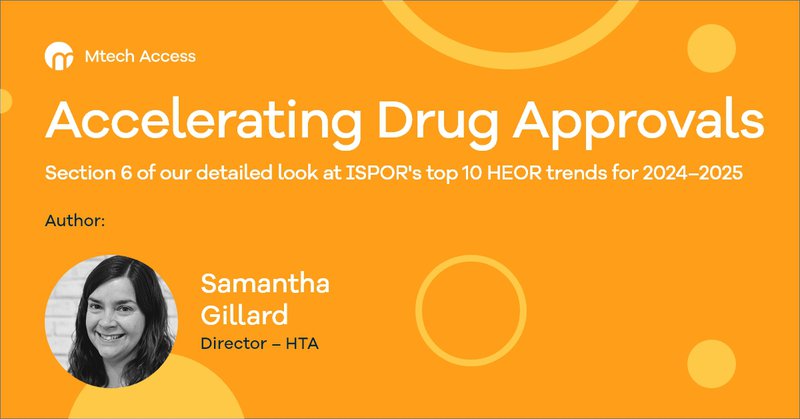
The goal for both drug manufacturers and healthcare professionals is to make medicines available to patients as soon as possible. This is particularly true in rare diseases and cancer where no treatments are currently available and/or patient survival rates are exceptionally low. However, this presents a challenge, with new drugs taking an average of 10 to 15 years to get from the bench to a patient, and less than 10% of drug candidates making it into Phase 2 trials (1).
Overcoming challenges associated with accelerated assessment
Changes in regulatory processes in recent years have sought to facilitate faster drug approvals. In the USA, these include the Fast Track, Breakthrough Therapy, Priority Review, or Accelerated Approval pathways (2). In Europe, drugs may undergo accelerated assessment, conditional marketing authorisation, or approval under extraordinary circumstances (3).
While these are positive initiatives, they may pose challenges for drug manufacturers for several reasons. Firstly, data may be limited to Phase 2 trials, which can be short in duration. Furthermore, these trials may use surrogate endpoints and may not include a comparator arm. The result being that there is potential for significant uncertainty in the efficacy of a drug.
HEOR plays a vital role in filling data gaps that may exist. In the case of a product where only surrogate endpoints are available, additional data are needed to prove that the these translate into clinically relevant patient outcomes. A systematic literature review may be used to identify evidence that surrogate markers do indeed translate into clinical endpoints.
Similarly, if only short-term data are available, additional evidence is required to estimate the longer-term clinical impact that the therapy may have. Some of the potential uncertainty with immature datasets could be addressed by health economic modelling, informed by clinical experts.
HEOR can also step in to help when no comparator data were collected in the trial. In such cases, techniques such as matching-adjusted indirect comparison (MAIC) or using RWE may be used to generate a synthetic control arm.
The “fourth hurdle”: Health technology assessment
It is also important to remember that, in most countries, regulatory approval does not automatically translate into market access and reimbursement. Drugs also need to pass the “fourth hurdle” of a positive recommendation by an HTA body to get reimbursement.
Unlike regulatory approval, which is limited to efficacy and safety of a drug, HTA also considers the cost-effectiveness of a product. This is essentially whether it is ‘good value for money’ to the healthcare system, relative to current standard of care. Drug manufacturers are therefore challenged with not only considering the efficacy and safety of their treatment, but also the overall cost of their treatment relative to current standard of care.
In the UK it takes around 18 months from the beginning of the NICE process until a recommendation for the drug is published, and a further 90 days for the funding mandate to be granted. These timelines assume that the drug is recommended at the first NICE committee meeting, which is not always the case. If additional committee meetings are needed, the timelines will be extended further. While NICE are looking to expedite their timelines with the introduction of new assessments, such as the proportionate approach (4), this is not suitable for all drugs.
Accelerated approvals can be a win-win situation for everyone, provided drug manufacturers are fully aware of the limitations of their evidence package and make every attempt to fill data gaps ahead of submission to both regulatory authorities and HTA bodies.
References
- Sun D, Gao W, Hu H, Zhou S. Why 90% of clinical drug development fails and how to improve it? Acta pharmaceutica Sinica B. 2022;12(7):3049-62.
- U.S. FDA CDER. Advancing Health Through Innovation: New Drug Therapy Approvals. 2022. Available from: https://www.fda.gov/drugs/new-drugs-fda-cders-new-molecular-entities-and-new-therapeutic-biological-products/new-drug-therapy-approvals-2022#innovation. Accessed February 2024.
- EMA. Human Medicines Highlights. 2022. Available from: https://www.ema.europa.eu/en/documents/report/human-medicines-highlights-2022_en.pdf. Accessed February 2024.
- NICE. Proportionate approach to technology appraisals: final report 2022–23. 2023. Available from: https://www.nice.org.uk/Media/Default/About/what-we-do/PATT/PATT-final-report-2022-23.pdf. Accessed February 2024.
Value Measurement
Author: Kaylie Metcalfe (Consultant– Health Economics).
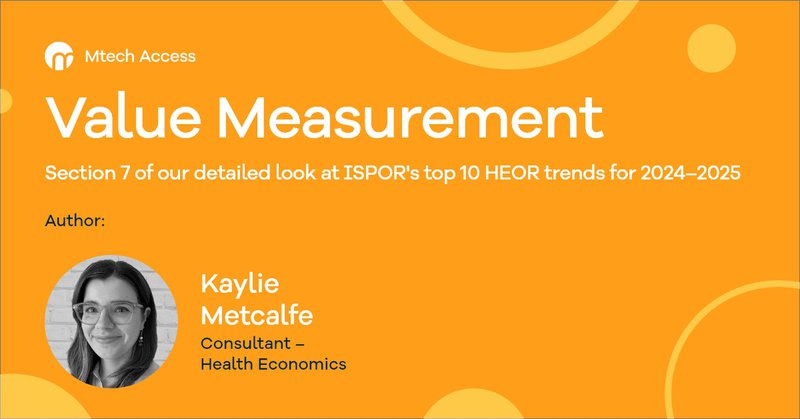
QALYs as the value measure of choice
For a long time, health technology assessment (HTA) agencies have considered quality-adjusted life years (QALYs) the measure of choice for valuing health outcomes. QALYs allow assessment of both the quality and quantity of life and are required for cost-utility analyses where the cost per QALY of two or more treatments is compared.
To determine the cost-effectiveness of a new treatment versus the current standard of care, the incremental costs are divided by the incremental QALYs. This gives us the incremental cost-effectiveness ratio, which can be compared against a willingness-to-pay threshold.
In the context of HTAs, the amount a health system is willing to pay for an additional health outcome (i.e. QALY) is different for the different agencies. For NICE, this is typically between £20,000 and £30,000 per QALY (1), whereas for the Institute for Clinical and Economic Review (ICER) in the USA, this can be between US$100,000 and US$150,000 per QALY (2).
Criticism and alternatives for QALY
Although use of the QALY measurement is standard practice for many economic evaluations used for HTA, it is not without criticism. A key concern is that a life extension for a person with poor baseline health-related quality of life (HRQoL) generates fewer QALYs than an equivalent extension of life for a person with good HRQoL. This measure may therefore be considered discriminative of people with chronic conditions, disabilities, and the elderly (3).
Increasingly, HTA agencies are considering alternatives to the QALY, and different ways of addressing such perceived discrimination. For example, ICER use the equal value of life years gained (evLYG) measure. With evLYG, equal weighting is given to a year of life added for a vulnerable patient population, and a year of life for healthier members of the community (4).
In the UK, since the publication of the new methods guide in early 2022 (1), NICE now consider the use of decision modifiers in the form of QALY weights. QALY weightings for disease severity are used – the more severe the condition, the higher the weighting. The aim of this again is to address the perception of patient outcomes being undervalued in cases where baseline HRQoL is poor. Other HTA agencies, such as Sweden’s Dental and Pharmaceutical Benefits Agency and the Scottish Medicines Consortium (5), also use decision modifiers. It is possible that such an approach may be used more widely as exposure to the use of modifiers and understanding grows.
It is clear that there are limitations with the QALY, and the conversation is ever evolving. However, we are constrained by the preferences of HTA agencies and how this plays a part in decision making. It is not a simple ‘switch’, and there are interdependencies to be considered.
For example, the use of different value measures will require reassessment of cost-effectiveness criteria, as decision makers often rely on the consideration of a willingness-to-pay threshold that is based on the cost per QALY metric.
However, the recent introduction of new ways to overcome the challenges associated with the use of QALYs has been a positive step, and it is important to be cognisant of these advances.
In the context of HTA and outside of it, it is important to challenge how patient outcomes are measured and be aware of the complete picture. Aside from what is possible to capture within a QALY calculation, what is the value of a new treatment to patients? Considering alternative value measurement methodologies and ensuring patients are engaged in these types of questions may help to build this picture.
References
- NICE. NICE health technology evaluations: the manual. 2022. Available from: https://www.nice.org.uk/process/pmg36/resources/nice-health-technology-evaluations-the-manual-pdf-72286779244741. Accessed February 2024.
- ICER[HS1] . ICER’s Reference Case for Economic Evaluations: Elements and Rationale. 2023. Available from: https://icer.org/wp-content/uploads/2023/10/ICER_Reference-Case_For-Publication_Sept2023.pdf. Accessed February 2024.
- Paulden M, Sampson C, O’Mahony JF, Spackman E, McCabe C, Round J, et al. Logical Inconsistencies in the Health Years in Total and Equal Value of Life-Years Gained. Value in Health. 2023[KM2] . S1098-3015(23)06201-0. Online ahead of print.
- ICER. Value Assessment Framework. 2023. Available from: https://icer.org/wp-content/uploads/2023/10/ICER_2023_VAF_For-Publication_101723.pdf. Accessed February 2024.
Patient Centricity
Author: Louise Maddison (Senior Consultant – Global Market Access).
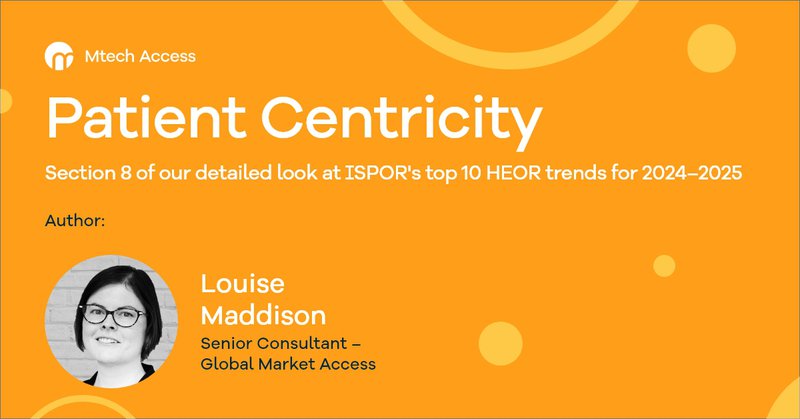
Hearing the patient voice
Patient centricity is becoming a core element of product and service development as more patients and their caregivers are now proactively seeking inclusion and transparency in the treatment decision-making process (1). A cultural shift is evolving whereby manufacturers and service leads are actively listening to what the patient needs, rather than purely focusing on the impact of the intervention on symptoms. Understanding the broader impact on patients’ lives is vital in contributing to the service or product’s value.
There is a clear need for industry to partner with patients across the value chain from research, development, distribution, and access, to co-create meaningful solutions and bring about better improved outcomes. Engaging the patient with plain language summaries, patient-focused endpoint strategy, and patient-centric clinical trials is a useful starting point.
Some pharmaceutical manufacturers are going one step further as they realise the importance of the patient voice throughout their organisation. These companies are shifting their operating models to embed patient-centric processes across product development and commercialisation (2,3).
One area of the healthcare industry that inputs the user voice upfront to co-create solutions is Medtech, with its reach into consumer and digital health. There are learnings from the development of wearables, patient apps, and healthcare devices via ‘design thinking approach’ and other methodologies (e.g. Agile), which could be transferred to pharmaceutical and service development.
Financial risks of not embracing patient-centricity
With rapidly rising healthcare costs and constrained budgets, payers are increasingly looking to reduce costs and improve both quality of care and health equity through value-based healthcare management and outcome-based payments (4). Additionally, regulators are increasingly demanding patient experience data, and health technology assessment (HTA) agencies are seeking evidence that demonstrates value to patients (5-11).
Failure to listen to patients and to collaborate on solutions they desire, rather than what you think they need, will result in products and services with limited value and uptake which in turn leads to poor outcomes. There could be financial consequences not only for the manufacturer (e.g. outcome-based agreements), but also more widely for the healthcare system, with increased healthcare resource utilisation and added pressure to already stressed systems.
Working with patients early on through compliant engagement, to hear their lived experiences, can offer valuable insights to inform disease area strategies, product development, and patient services. Coupled with broader artificial intelligence-driven insights from real-world patient data (e.g. social media, electronic healthcare records), further innovation of patient-centric solutions can be realised.
The integration of patient-centricity across all stages of the product and service development lifecycle is essential to provide treatment interventions for patients that meet their needs. Consider the impact of patient centricity in the wider healthcare ecosystem, and work with patients and partners to co-create best in class products and services. The result will be enhanced patient experience and improved health outcomes, so that patients can live better lives.
References
- Vanstone M, Canfield C, Evans C, Leslie M, Levasseur MA, MacNeil M, et al. conceptualizing patients as partners in health systems: a systematic review and descriptive synthesis. Health Research Policy and Systems. 2023;21(12):1-14.
- Sharma R, Ahmed S, Campagnari J, Huff W, Lloyd L. Embedding Patient‑Centricity by Collaborating with Patients to Transform the Rare Disease Ecosystem. Pharmaceutical Medicine.2023;37:265-273.
- Patients as Partners in Clinical Research. Novartis’ Bold Vision to Change How the Entire Sector Engages Patients. 2023. https://theconferenceforum.org/editorial/novartis-global-head-of-patient-engagements-bold-vision-to-change-how-the-entire-sector-engages-patients. Accessed January 2024.
- Lewis C, Horstman C, Blumenthal D, Abrams MK. Commonwealth Fund: Value-Based Care: What It Is, and Why It’s Needed. 2023. Available from: https://www.commonwealthfund.org/publications/explainer/2023/feb/value-based-care-what-it-is-why-its-needed. Accessed January 2024.
- U.S. FDA. FDA Patient Engagement Overview. 2020. Available from: https://www.fda.gov/patients/learn-about-fda-patient-engagement/fda-patient-engagement-overview. Accessed January 2024.
- U.S. FDA. FDA patient-focused drug development guidance series for enhancing the incorporation of the patient’s voice in medical product development and regulatory decision making. 2024. https://www.fda.gov/drugs/development-approval-process-drugs/fda-patient-focused-drug-development-guidance-series-enhancing-incorporation-patients-voice-medical. Accessed January 2024.
- EMA. Engagement Framework: EMA and patients, consumers and their organisations. 2022. Available from: https://www.ema.europa.eu/en/documents/other/engagement-framework-european-medicines-agency-and-patients-consumers-and-their-organisations_en.pdf. Accessed January 2024.
- EMA. Patient experience data in EU medicines development and regulatory decision-making. 2022. Available from: https://www.ema.europa.eu/en/documents/other/executive-summary-patient-experience-data-eu-medicines-development-and-regulatory-decision-making-workshop_en.pdf. Accessed January 2024.
- MHRA. Patient involvement strategy: one year on. 2023. Available from: https://www.gov.uk/government/publications/patient-involvement-strategy-one-year-on/patient-involvement-strategy-one-year-on#progress-made. Accessed January 2024.
- European Network for Health Technology Assessment. Guidance on patient and healthcare professional involvement. 2023. Available from: EUnetHTA-21-D7.2-Guidance-for-involvement-of-patient-and-clinical-expert-in-JSC-and-JCA-v1.0.pdf. Accessed January 2024.
- Single ANV, Facey KM, Livingstone H, Silva AS. Stories of Patient Involvement Impact in Health Technology Assessments: A Discussion Paper. International Journal of Technology Assessment in Health Care. 2019;35(4):266-272.
Precision Medicine
Author: Stephanie Swift (Senior Consultant – Systematic Review).
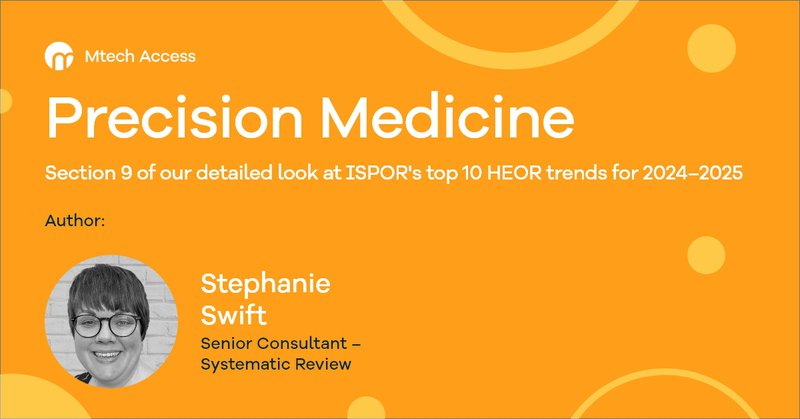
What is precision medicine?
Precision medicine is a healthcare approach that treats patients based on biological characteristics, such as their genetic profile. It has broad applications across a wide range of indications, including oncology, inherited genetic diseases, orphan diseases, infectious diseases, and more.
Yet achieving precisely targeted treatment outcomes often comes with a hefty price tag that restricts their cost-effective use to a small, very defined patient population.
Precision medicine for rare diseases
For rare diseases caused by specific genetic mutations, precision medicine can offer a potentially curative solution for patients who otherwise would continue to experience severe and debilitating symptoms. For example, CRISPR therapies can edit faulty genes, and gene therapies can supply functional copies of mutated genes to offer precisely targeted treatment solutions. While several recent HTA submissions for these kinds of therapies in the rare disease space have come with a list price of over £3 million, these can still be approved as cost effective due to the small number of affected patients who are eligible for treatment.
Precision medicine for oncology
In the oncology space, precision medicine can be used to target tumours based on their component genetic mutations. Many tumours share key mutations, particularly when they arise in similar tissues, like the lung or pancreas. Precision medicine can target these common mutations across patients to provide an off-the-shelf therapy based on a shared genetic profile.
Alternatively, the unique genetic ecosystem inherent to each individual patient’s tumour can be leveraged in customised precision treatments, such as adoptive T cell therapy and CAR-T cell therapy. These approaches harvest patient immune cells, manipulate them ex vivo in the lab, and reinfuse them back into the patient.
But cell therapies are also expensive – with some HTA submissions reaching a list price of more than £300,000 per infusion.
Further applications
Beyond rare diseases and oncology, patient unique genetic signatures can be targeted to provide a wide range of health improvements, from microbiome transplantation, to enhanced gut health, to predicting and preventing the development of new diseases, such as diabetes or Alzheimer’s disease. Prediction modelling, point of care diagnostics, digital health, and machine learning are all being expanded within the precision medicine space to provide clinically meaningful insights that can have a substantial impact on human health.
Future perspectives
Several global ‘grand challenge’ initiatives continue to work on bringing down the cost of precision medicines to enable broader patient access, including the establishment of genomic networks of excellence in England that will embed artificial intelligence into the personalised medicine pathway of care (1).
As the cost of genome sequencing also continues to fall, this creates a future where understanding a patient’s genetics can become a cost-effective way to drive their choice of treatment and enhance their prognosis. As the precision treatment pathway becomes cheaper, more precisely targeted treatments are likely to be recommended that improve patient outcomes on a large scale and drive a revolution in conventional treatment paradigms.
References
- NHS England. Genomic Networks of Excellence. Available from: https://www.england.nhs.uk/genomics/nhs-genomic-networks-of-excellence/. Accessed February 2024.
Public Health Policy
Author: Robert Hull (Senior Consultant – NHS Insight & Interaction).
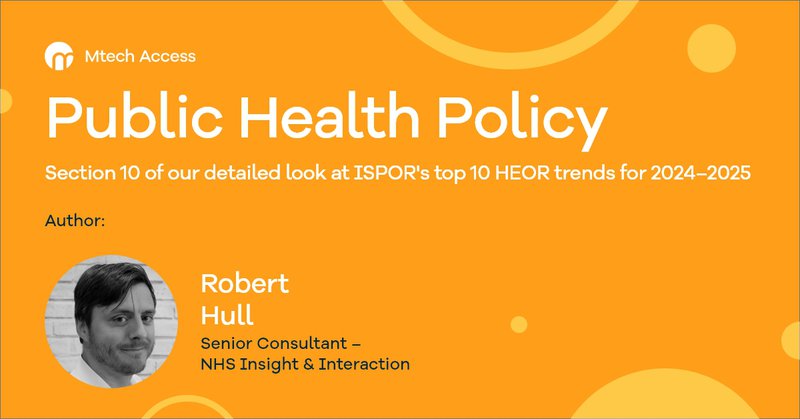
Since the COVID-19 pandemic, public health policy (PHP) has been in sharper focus than ever before. Health and care systems across the globe struggle with the challenges of ageing populations, high burdens of chronic diseases, and rising costs.
These challenges are compounded by global factors such as climate change and economic recessions alongside more local issues, such as recruitment and retention of the workforce required to meet the needs of these health and care systems. Significant transformation is needed to meet these challenges, including the adoption of innovative technologies and redesigning of clinical pathways.
Public health policy in England
The NHS long term plan (1) lays out the key aims and focuses of PHP in England. Companies who can align their medicines and technologies to these key areas and other national priorities are likely to receive greater traction in the NHS and could be eligible for additional funding opportunities.
A significant area of focus for the government is the ‘Core20PLUS5’. The Core20PLUS5 lays out the key clinical areas that affect the most vulnerable adults (2), children, and young people (3) in England. There is considerable scope for innovative approaches that support these populations and clinical challenges, for companies who are able to demonstrate value and impact.
The NHS is also looking for greater use of virtual wards and artificial intelligence (AI) to enable more efficient delivery of healthcare. Virtual wards can reduce the need for people to attend comparatively expensive hospitals and instead allow them to be treated in the community (4). However, these pathways must be well evidenced and evaluated in order to be seen as suitable for adoption.
The adoption of AI technologies can allow NHS staff to be more efficient. Key initiatives include AI software to support clinicians in identifying cancers more rapidly, and clinical pathway redesign to remove bottle necks and automate administrative tasks.
Beyond immediate clinical transformation, the NHS looks to reduce its climate impact through its Net Zero agenda, recognising that climate change and carbon emissions have a significant impact on our health (5). From April 2024, all companies looking to supply to the NHS will need to publish their carbon reduction plan (previously this was only for contracts greater than £5 million) (6).
Implications for industry
It is insufficient for companies to simply align to these goals. The NHS remains under considerable financial pressure. Any new intervention must be supported by robust health economic data that are able to demonstrate a thorough understanding of the systems and pathways to be disrupted, the stakeholders who will be involved, and the costs that can be released through implementation.
Companies looking to understand these areas in greater depth should look to our NHS Insight & Interaction team and Deep Insights reports. These will help companies to understand the top priorities of NHS organisations, their measures of success and overall strategy, how to influence them, and the key language to use to ensure that communications are as impactful as possible.
References
- NHS. The NHS Long Term Plan. 2019. Available from: https://www.longtermplan.nhs.uk/publication/nhs-long-term-plan/. Accessed February 2024.
- NHS England. Core20PLUS5 (adults) – an approach to reducing healthcare inequalities. Available from: https://www.england.nhs.uk/about/equality/equality-hub/national-healthcare-inequalities-improvement-programme/core20plus5/. Accessed February 2024.
- NHS England. Core20PLUS5 infographic – Children and young people. 2022. Available from: https://www.england.nhs.uk/long-read/core20plus5-infographic-children-and-young-people/. Accessed February 2024.
- NHS England. Virtual wards. Available from: https://transform.england.nhs.uk/information-governance/guidance/virtual-wards/. Accessed February 2024.
- NHS England. Greener NHS. Available from: https://www.england.nhs.uk/greenernhs/. Accessed February 2024.
- NHS England. Greener NHS Suppliers. Available from: https://www.england.nhs.uk/greenernhs/get-involved/suppliers/. Accessed February 2024.
We would love to hear your thoughts on the trends and the research initiatives mentioned above. To share your views please email info@mtechaccess.co.uk.


